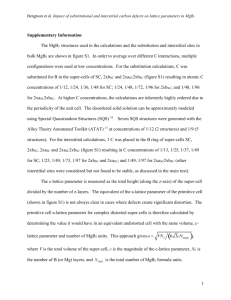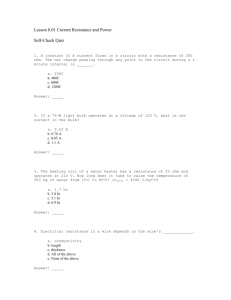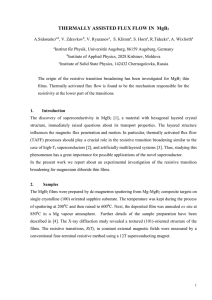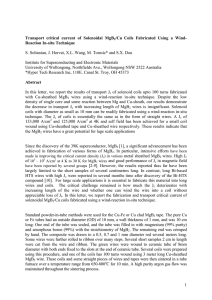FT/P1-18 Development of Low activation Superconducting material
advertisement
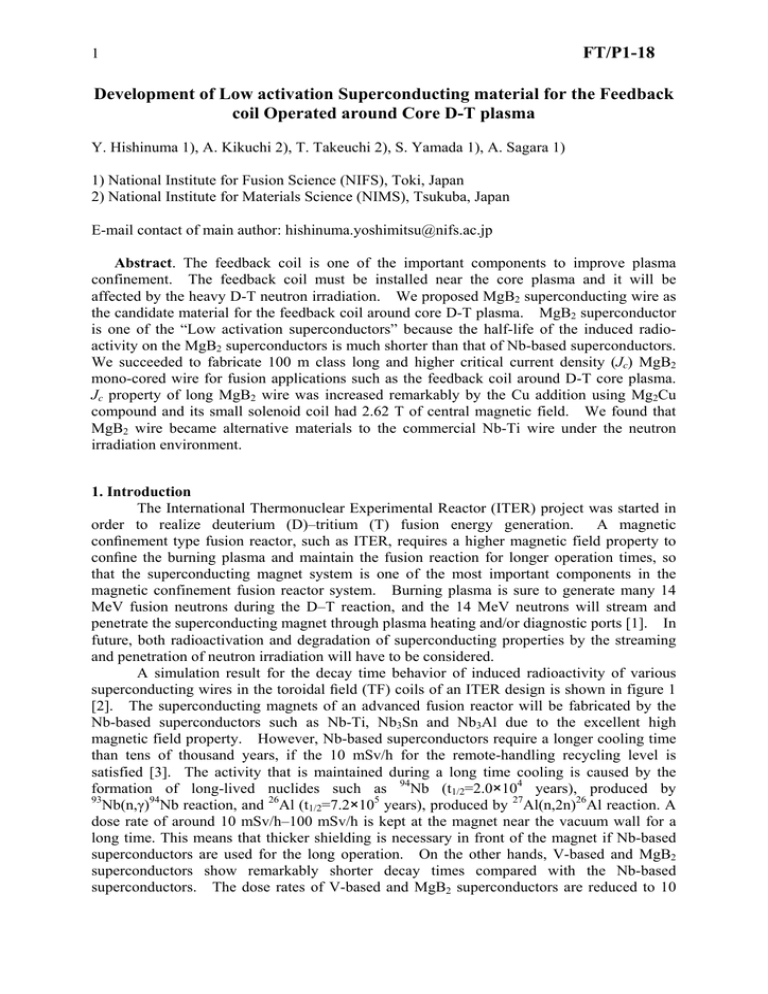
1 FT/P1-18 Development of Low activation Superconducting material for the Feedback coil Operated around Core D-T plasma Y. Hishinuma 1), A. Kikuchi 2), T. Takeuchi 2), S. Yamada 1), A. Sagara 1) 1) National Institute for Fusion Science (NIFS), Toki, Japan 2) National Institute for Materials Science (NIMS), Tsukuba, Japan E-mail contact of main author: hishinuma.yoshimitsu@nifs.ac.jp Abstract. The feedback coil is one of the important components to improve plasma confinement. The feedback coil must be installed near the core plasma and it will be affected by the heavy D-T neutron irradiation. We proposed MgB2 superconducting wire as the candidate material for the feedback coil around core D-T plasma. MgB2 superconductor is one of the “Low activation superconductors” because the half-life of the induced radioactivity on the MgB2 superconductors is much shorter than that of Nb-based superconductors. We succeeded to fabricate 100 m class long and higher critical current density (Jc) MgB2 mono-cored wire for fusion applications such as the feedback coil around D-T core plasma. Jc property of long MgB2 wire was increased remarkably by the Cu addition using Mg2Cu compound and its small solenoid coil had 2.62 T of central magnetic field. We found that MgB2 wire became alternative materials to the commercial Nb-Ti wire under the neutron irradiation environment. 1. Introduction The International Thermonuclear Experimental Reactor (ITER) project was started in order to realize deuterium (D)–tritium (T) fusion energy generation. A magnetic confinement type fusion reactor, such as ITER, requires a higher magnetic field property to confine the burning plasma and maintain the fusion reaction for longer operation times, so that the superconducting magnet system is one of the most important components in the magnetic confinement fusion reactor system. Burning plasma is sure to generate many 14 MeV fusion neutrons during the D–T reaction, and the 14 MeV neutrons will stream and penetrate the superconducting magnet through plasma heating and/or diagnostic ports [1]. In future, both radioactivation and degradation of superconducting properties by the streaming and penetration of neutron irradiation will have to be considered. A simulation result for the decay time behavior of induced radioactivity of various superconducting wires in the toroidal field (TF) coils of an ITER design is shown in figure 1 [2]. The superconducting magnets of an advanced fusion reactor will be fabricated by the Nb-based superconductors such as Nb-Ti, Nb3Sn and Nb3Al due to the excellent high magnetic field property. However, Nb-based superconductors require a longer cooling time than tens of thousand years, if the 10 mSv/h for the remote-handling recycling level is satisfied [3]. The activity that is maintained during a long time cooling is caused by the formation of long-lived nuclides such as 94Nb (t1/2=2.0×104 years), produced by 93 Nb(n,γ)94Nb reaction, and 26Al (t1/2=7.2×105 years), produced by 27Al(n,2n)26Al reaction. A dose rate of around 10 mSv/h–100 mSv/h is kept at the magnet near the vacuum wall for a long time. This means that thicker shielding is necessary in front of the magnet if Nb-based superconductors are used for the long operation. On the other hands, V-based and MgB2 superconductors show remarkably shorter decay times compared with the Nb-based superconductors. The dose rates of V-based and MgB2 superconductors are reduced to 10 2 FT/P1-18 104 V3Ga 102 Dose Rate (Sv/hour) V2Zr Nb3Al 100 Nb3Sn Remote 10-2 Nb-Ti V3Si 10-4 Hands-on V2(Zr,Hf) 10-6 MgB2 10-8 10-4 10-2 100 102 104 106 Period after shutdown (Year) FIG. 1: The decay time behaviors of the induced radioactivity on various superconducting wires in the toroidal field (TF) coils of an ITER design μSv/h for the hands-on maintenance level below 1 year [3]. This suggests that the hands-on maintenance of these materials is possible because of their short-time cooling. We thought that the V-based and MgB2 compounds could be suitable as candidate materials for a ‘low activation superconducting magnet’ for a fusion reactor application. MgB2 superconducting compound was discovered in 2001 [4]. Many R&D activities concerned with MgB2 wires and bulk materials were carried out for practical applications under 20 K operation. The features of the MgB2 compound are a higher critical temperature (Tc) of 39 K, simple binary chemical composition, lower specific gravity and relatively low cost material. For future applications, we investigated the possibility of applying MgB2 superconducting wire in an advanced nuclear fusion power plant system because its radioactivity property is lower than for Nb-based superconductors, and the lower refrigeration load on the cryogenic system due to its higher Tc property. In the view points of the fusion reactor applications, the Poloidal field (PF) and feedback coils will be constructed by Nb–Ti alloy and they require a larger coil radius to correct the position of the plasma. In the concept of a low activation superconducting coil system for a fusion reactor, MgB2 superconducting wire was an alternative material for Nb–Ti alloy wire for the PF and feedback coils if the critical current density (Jc) around lower magnetic field region could be improved. Recently, doping of nanoparticle SiC into anMgB2 matrix has been carried out to improve Jc-B properties [5, 6]. SiC doping into an MgB2 matrix was effective at improving Jc properties in high magnetic field due to the improvement of the irreversibility field (Birr) by co-substitution of Si and C in the MgB2 crystal lattice. In this work, we investigate Cu addition using Mg2Cu compound in the MgB2 phase synthesized by conventional processes with the purpose of improving Jc without lowering Tc. The Mg2Cu compound is an intermetallic brittle material, so it is easy to fabricate fine particle powders by mechanical grinding. The Mg2Cu compound is expected to promote the diffusion reaction to form higher Tc MgB2 than SiC-doped MgB2 wires at lower temperatures due to no-oxidation and a lower melting point than metal Mg [7-9]. Furthermore, we also tried to fabricate 100 m classed mono-cored Ta sheathed wire samples having stabilized Cu in order to investigate the workability of a Ta sheathed sample for the possibility of application 3 FT/P1-18 in an advanced fusion reactor in order to realize low activation MgB2/Ta sheathed wire for fusion application. 2. Sample procedure and experiment Precursor mixture powders were made by metal Mg powder (99.9%, −200 mesh), Mg2Cu compound and amorphous B powder (99.9%, −submicron). It was difficult to disperse the Mg2Cu compound homogeneously into the precursor powder due to the hard and brittle material and large grain size, so that the Mg2Cu compound was only crushed mechanically into fine powder using a ball-milling process for 3 h. The composition ratios of precursor powders were adjusted to 1 at.% Cu and 3 at.% Cu composition from the viewpoint of better results for the Jc–B performance [6, 7] and these source powders were mixed in the following two kinds of the molar ratios; 0.98 Mg:0.01 Mg2Cu:1.99 B—(1at.% Cu composition) 0.94 Mg:0.03 Mg2Cu:1.94 B—(3at.% Cu composition) The mixture powders were tightly packed into metal Ta tubes (purity of 99.99%) with 10 mm outer diameter and 6 mm inner diameter. The metal sheathed material required not only a low activation property but also workability, mechanical strength, non-magnetization and non-corrosion. Thus the metals Ta was selected by these requirements. Wire drawing was carried out using grooved-roller and cassette-roller dies, and the precursor wires had a final diameter of about 1.04 mm. The prepared short sample wires were heat treated using a low temperature diffusion process which used various temperatures and times from 400 to 500℃ and from 100 to 700 h in an Ar atmosphere. After heat treatment, Tc and the transport critical current Ic (4.2 K) were measured using a DC four-probe method. Jc values of all samples were defined as the Ic values divided by the cross-sectional area of the powder-filled core, and these Jc values were the so-called ‘core Jc’. Furthermore, the nuclear heat generation will be caused by the D-T neutron irradiation in the case of the feedback coil around D-T plasma. The heat load of the correction coil is increased by the nuclear heat generation and the coolant temperature will be elevated by the heat load. The temperature margin between Tc value and operation temperature is one of the important factors to select superconducting materials of the feedback coil. In order to evaluate the ambient temperature dependence of the Ic-B performances, Ic-B measurement as a function of the ambient temperature was carried out. The ambient temperature of the sample was controlled by a flow of cold helium gas, a non-inductive heater and cernox thermometer. We also tried to fabricate 100 m classed long mono-cored Ta sheathed wire samples having stabilized Cu in order to investigate the workability of a Ta sheathed sample for the possibility of practical application in an advanced fusion reactor. The stabilized Cu is used to prevent the thermal running and quench. The small solenoid coil using a part of the long MgB2 mono-cored wire was fabricated, and excitation test of the small coil at 4.2 K was carried out to investigate the coil performance and reliability of the long wire deformation. 3. Results and discussions 3.1. Tc and Jc-B property improvements of Cu addition MgB2/Ta wire The typical normalized electrical resistivity (R)–temperature (T) curves of MgB2/Ta sheathed wires synthesized with various low-temperature diffusion processes are shown in figure 2. In the case of 400℃ heat treatment, no superconducting transition was observed within 20 K. However, sharp superconducting transitions were observed in the samples over 425℃ heat treatment, and then the maximum offset Tc value was obtained to be about 36 K in the 475℃ sample. It was clear that a high Tc MgB2 phase was formed by carrying out the 4 FT/P1-18 (6) (6) FIG. 2: The normalized electrical resistivity (R)–temperature (T) curves of MgB2/Ta sheathed wires synthesized by various lowtemperature diffusion processes. FIG. 3: Typical Jc–B performances of Ta sheathed wires when heat treated at 450℃ for long time. Cu addition process for a longer time at 450℃, which was lower than the conventional treatment. Furthermore, longer time treatment, such as 200 h, was effective in improving the Tc value in low-temperature treatment. We found that the high Tc MgB2 phase was possible to form by carrying out Cu addition and a low-temperature diffusion process. The typical Jc–B performances of Ta sheathed samples when heat treated at 450℃ were shown in figure 3. The core Jc property under the magnetic field of the Ta sheathed sample was increased by extending the treatment time: the optimum treatment time was defined as 200 h in the case of a heating temperature of 450℃. Then the typical present Jc– B performances of SiC doped and undoped MgB2/Fe tapes using MgH2 as Mg source material through conventional processes are also shown for comparison [6]. Jc values of the SiC doped and undoped Fe sheathed samples using MgH2 as Mg source material are higher than those of the samples produced via the metal Mg–B diffusion reaction [6]. The Jc–B performance of the Ta sheathed sample which was heat treated at 450℃ for 200 h was higher compared with that of undoped SiC Fe sheathed samples using MgH2. Furthermore, it is noteworthy that the core Jc value for samples which were heat treated at 450℃ for 200 h in a lower magnetic field than 6 T was improved remarkably in comparison with the SiC doped Fe sheathed sample. This was why the high purity MgB2 phase having a high Tc value of 35 K was promoted to form the core for the low-temperature diffusion process. These suggested that the Jc improvement without lowering Tc property of Ta sheathed samples was sufficient to carry out the low temperature diffusion process in the metal Mg–B diffusion process. On the other hand, it was noticed that the core Jc property of MgB2 wire by the low-temperature diffusion process was almost equivalent to the conventional Nb-Ti wire in the low magnetic field region and then the MgB2 wire was able to be an alternative material for Nb-Ti wires for a low activation superconducting magnet system in the low magnetic field region of an advanced fusion application. 3.2. The ambient temperature dependence of the Ic-B performance (Ic-B-T) of Cu addition MgB2/Ta wire The typical Ic-B-T propertie of Cu added MgB2/Ta mono-cored wires is shown in 5 FT/P1-18 figure 4. The Ic-B properties using liquid He cooling are also shown in figure 4 for the comparison. We observed that Ic-B was decreased with increasing the ambient sample temperature. And critical magnetic field (Hc2) of MgB2/Ta wire was also decreased with the ambient temperature. In the case of an ambient sample temperature of 20 K, a transport Ic value of 100 A was obtained in magnetic field of 1 tesla. This Ic value corresponds to a core Jc value of 600 A/mm2, estimated from the MgB2 core area for mono-cored wire, this MgB2/Ta wire could be applied to the low activation superconducting wire in high temperature and low magnetic region. However, Boron composed with MgB2 has two kinds of the major isotope, which are 10B and 11B (the natural abundance; 10B: 20%, 11B:80%). Considering of the heat load by the nuclear heat generation in MgB2 compound, the nuclear heat generation of MgB2 compound was decreased remarkably from 2.58 to 0.127 mW/cm3 if the isotope adjustment from 10B to 11B was carried out. This will be able to contribute the large tolerance of the operation temperature and coil design compared with Nb-Ti and Nb3Sn wire. It will be necessary to investigate Jc-B performance of the MgB2 wire using 11B isotope as the boron source material. 3.3. The manufacture of the 100 m classed Cu addition MgB2/Ta mono-cored wire having stabilized Cu and its small solenoid coil We tried and succeeded to fabricate 100 m classed mono-cored Ta sheathed wire samples having stabilized Cu in order to investigate the workability of the MgB2/Ta sheathed sample for the possibility of application in an advanced fusion reactor. The typical optical microscopic photograph of the cross-sectional area in the 100 m classed MgB2/Ta monocored wire having stabilized Cu after the low temperature diffusion process is shown in figure 5. The cross-section ratio of the large-scale wire was 20% of MgB2 core, 50% of Ta sheath (diffusion barrier material) and 30% of stabilized Cu, respectively. It was clear that the Ta sheathed wire was possible for carrying out large scale wire deformation processing exceeding 100 m without aberrational deformation. Then we found that Ta sheathed material with Cu cladding had good workability due to good adhesion between Ta and Cu cladding. Moreover, the reaction layer between the MgB2 core and the metal Ta sheath was not observed at the interface, and metal Ta was used as the barrier material between MgB2 and stabilized Cu. The small solenoid test coil was also fabricated using a part of the 100 m FIG. 4: Typical Ic-B-T property of the Cu addition MgB2/Ta mono-cored wire. 6 FT/P1-18 FIG. 5: Typical optical image of the crosssectional area of the 100 m length MgB2/Ta/Cu mono-cored wire. FIG. 6: The photograph of the small solenoid test coil using a part of the 100 m length MgB2/Ta/Cu mono-cored wire. TABLE. 1: The specification of the solenoid test coil using the MgB2/Ta/Cu mono-cored wire length MgB2/Ta mono-cored wire, its photograph and specification are shown in figure.6 and table.1. Before the winding to the coil case, glass sleeve was wrapped to the MgB2/Ta/Cu mono-cored wire in order to prevent the electrical short circuit in the solenoid coil. 3.4. The excitation test result of the solenoid coil using Cu addition MgB2/Ta/Cu monocored wire The small solenoid coil was sintered at 475℃ for 200 h in Ar atmosphere. This heat treatment was optimum condition from the Ic-B performance of the MgB2/Ta/Cu mono-cored wire. The heating rate was very slow, which rate is 200℃/h, because of the homogeneous heat treatment for the small coil. The excitation test of the solenoid coil at 4.2 K was carried out several times. I-V curves of the excitation test are shown in figure.7. The ramping rates were 1 and 5 A/sec in this test. In the excitation tests, coil Ic value was obtained to be a 230 A and no coil quench phenomena of the coil was confirmed. It suggested that the Cu clad materials acted as electrical stabilization due to good adhesion between the metal Ta and Cu. The comparison between Ic-B data of the short sample and load line of the solenoid coil is shown in figure 8. The coil Ic value was corresponded to about 88% of the Ic value of the short sample. This suggested the 88% of the high coil load factor was caused by the good wire deformation. The central magnetic field (B0) was estimated to be 2.62 T from the load- 7 Coil Voltage (mV) Coil Voltage (mV) FT/P1-18 Current (A) Current (A) Core Jc (A/mm2) Transport Ic (A) FIG. 7: I-V curves of the solenoid coil using MgB2/Ta/Cu mono-cored in the excitation test at 4.2 K. Magnetic field (T) FIG. 8: The comparison between Ic-B data of the short sample and the load line of the solenoid coil line of the solenoid coil. We found that MgB2 superconducting wire was promising to an alternative material of the Nb-Ti wire under the low magnetic field below 3 T and had the large potential as “Low activation superconductor” to applying for advanced fusion reactor. In the future, MgB2 is one of the new materials in the superconductors and it will be able to expand to the high magnetic field application area in fusion reactor if its superconductivity was remarkably improved. 4. Conclusions MgB2 superconductor is one of the “Low activation superconductors” because the half-life of the induced radio-activity on the MgB2 superconductors is much shorter than that of Nb-based superconductors. We succeeded to fabricate 100 m class long and higher critical current density MgB2 mono-cored wire for fusion applications. Jc property of long MgB2 wire was increased remarkably and its coil had 2.62 T of central magnetic field. We found that MgB2 wire had the large potential as “Low activation superconductor” to applying for advanced fusion reactor and became alternative materials to the commercial Nb-Ti wire under the neutron irradiation environment. 8 FT/P1-18 5. Acknowledgements This study was supported by the NIFS collaboration program (KKMF004) and KAKENHI [Grant-in-Aid for Young Scientists (B)] (#21760240) by the Ministry of Education, Culture, Sports, Science and Technology (MEXT). And authors would like to thank for Tsukuba Magnet Laboratory of NIMS for providing us with the chance to use high magnetic field magnet facilities for the Ic and Tc measurement. References [1] SATO, S., et al., “Evaluation of shutdown gamma ray dose rates around the duct penetration by three dimensional Monte Carlo decay gamma ray transport calculation with variance reduction method”, J. Nucl. Sci. Technol 39 (2002) 1237. [2] NODA, T., et al., “Induced activity of several candidate superconductor materials in a tokamak-type fusion reactor”, J. Nucl. Mater. 329–333 (2004) 1590. [3] MAKI, K., et al., JAERI-M 91-017. [4] NAGAMATSU, N., et al., “Superconductivity at 39 K in magnesium diboride”, Nature 410 (2001) 63. [5] DOU, S., X., et al., “Transport critical current density in Fe-sheathed nano-SiC doped MgB2 wires”, IEEE Trans. Appl. Supercond. 133 (2003) 3199. [6] MATSUMOTO, A., et al., “Effect of SiO2 and SiC doping on the powder-in-tube processed MgB2 tapes”, Supercond. Sci. Technol. 17 (2004) S319. [7] KIKUCHI, A., et al., “The synthesis of MgB2 superconductor using Mg2Cu as a starting material”, Supercond. Sci. Technol. 17 (2004) 781. [8] HISHINUMA, Y., et al., “Microstructure and superconductivity of Cu addition MgB2 wires using Mg2Cucompound as additional source material”, Supercond. Sci. Technol. 19 (2006) 1269. [9] HISHINUMA, Y., et al., “Superconducting properties and microstructure of MgB2 wires synthesized with a low-temperature diffusion process”, Supercond. Sci. Technol. 20 (2007) 1178.
